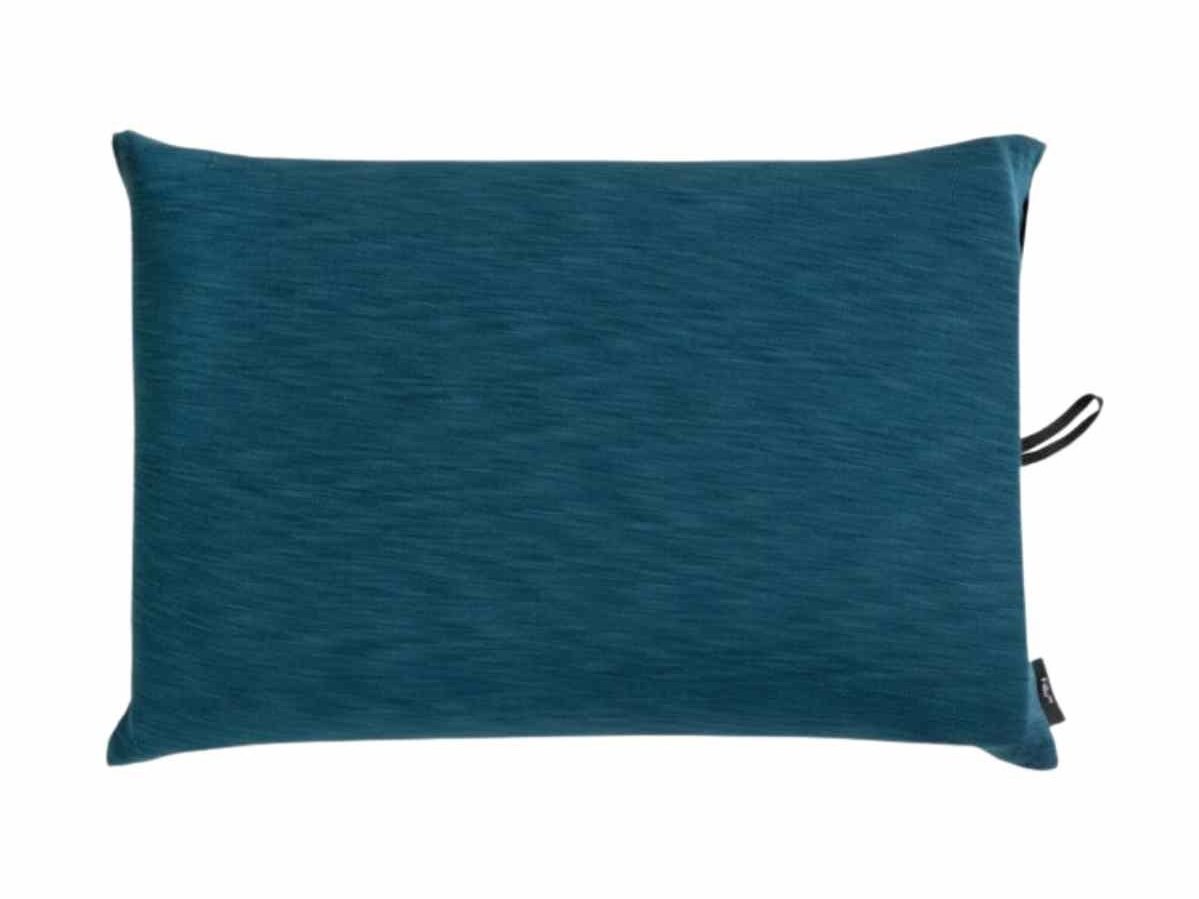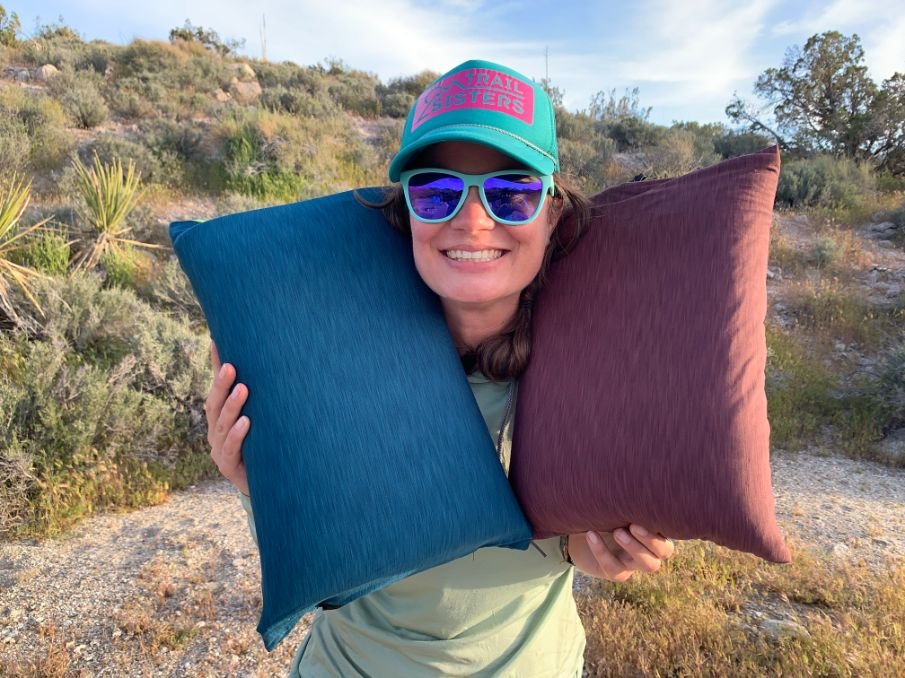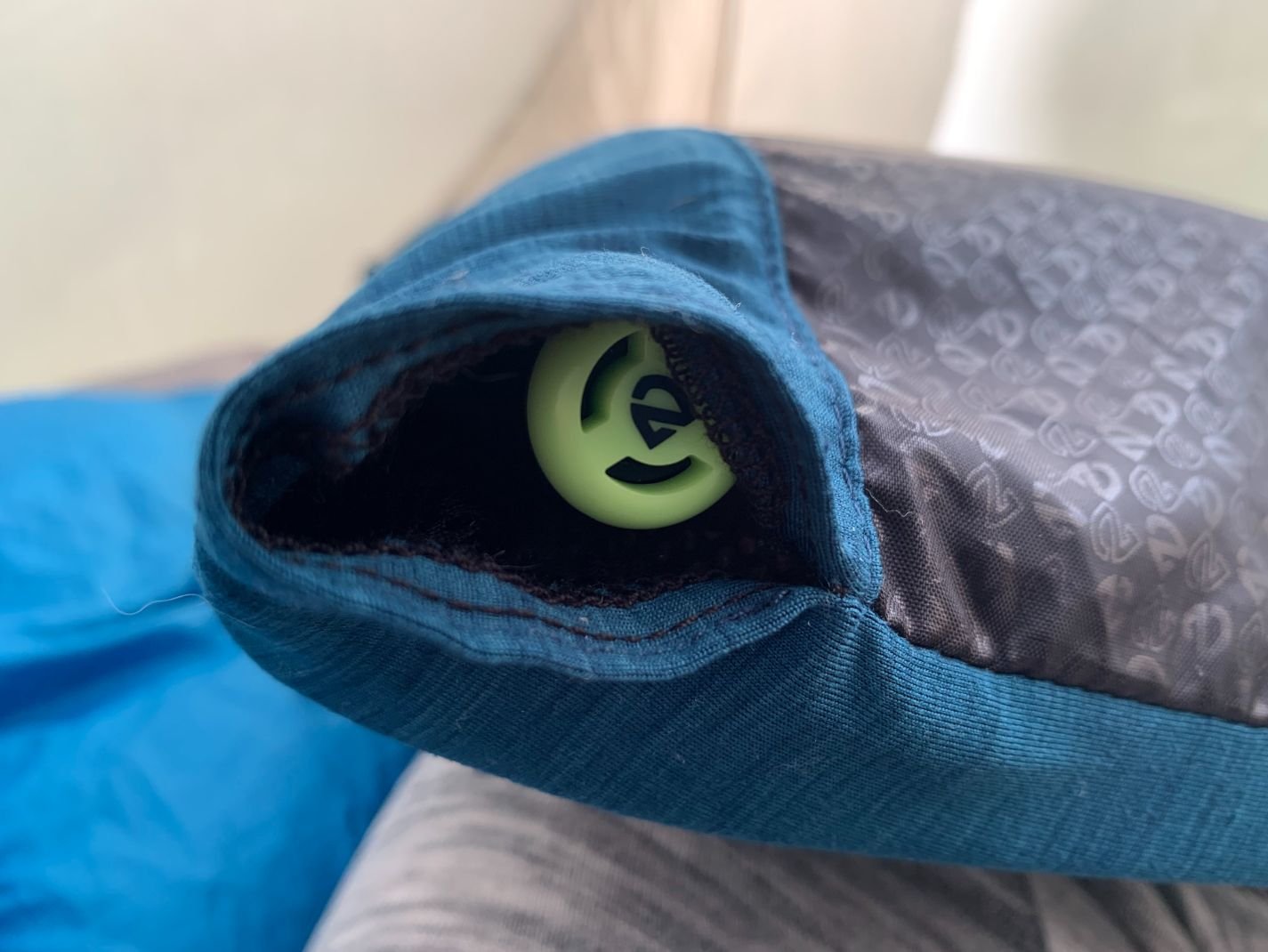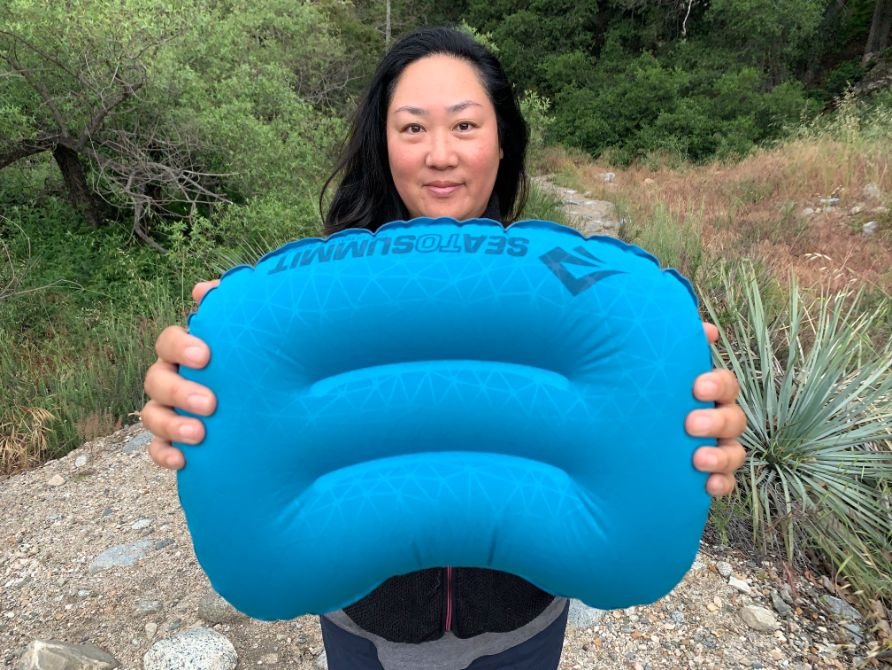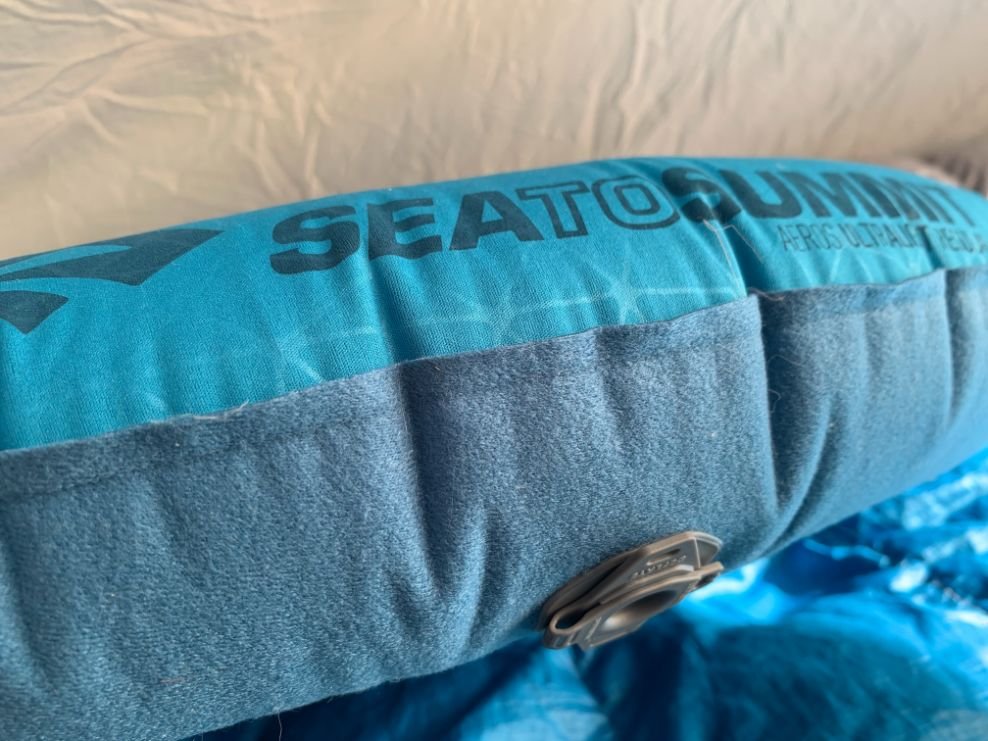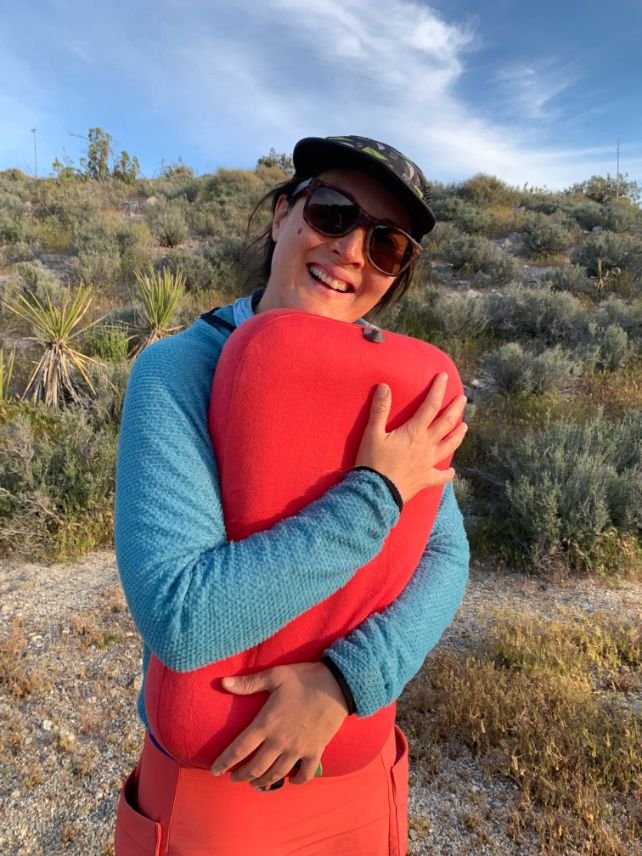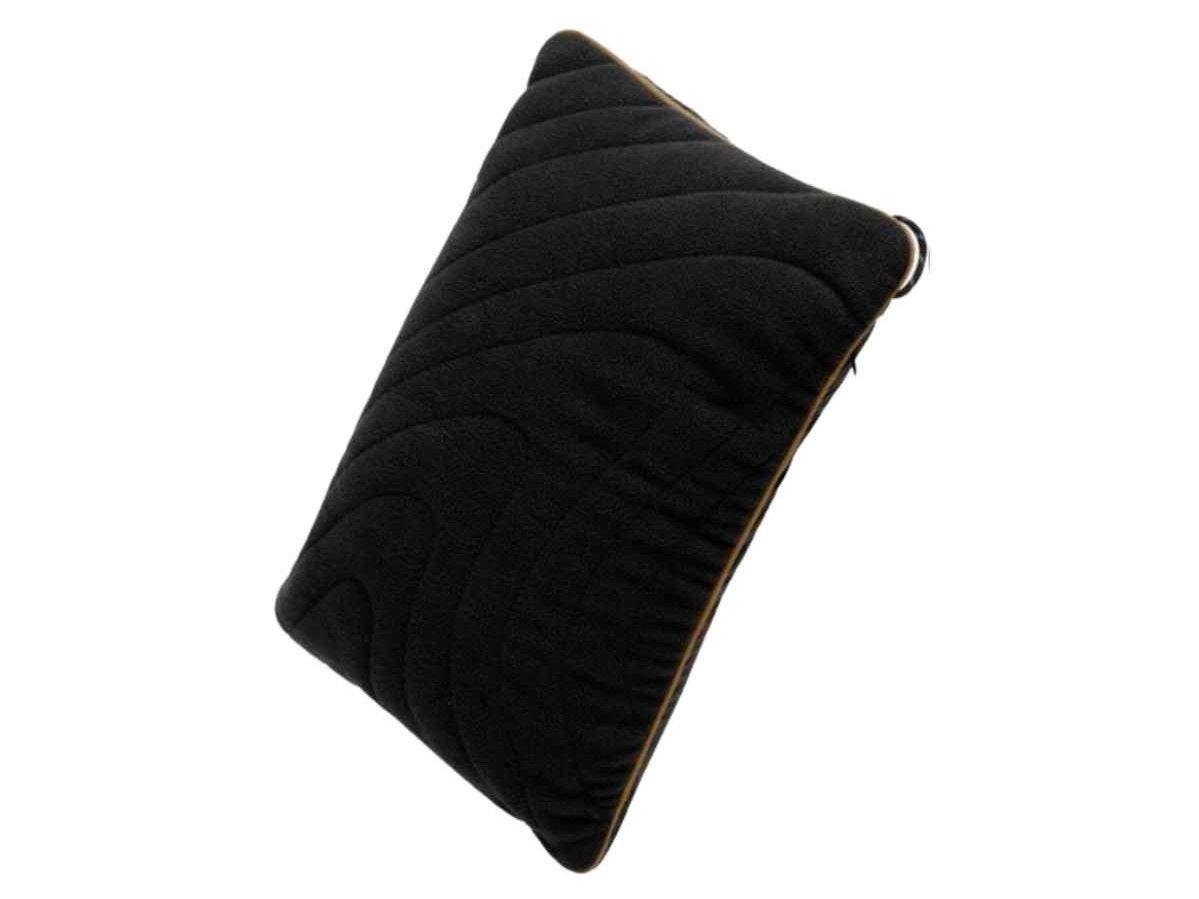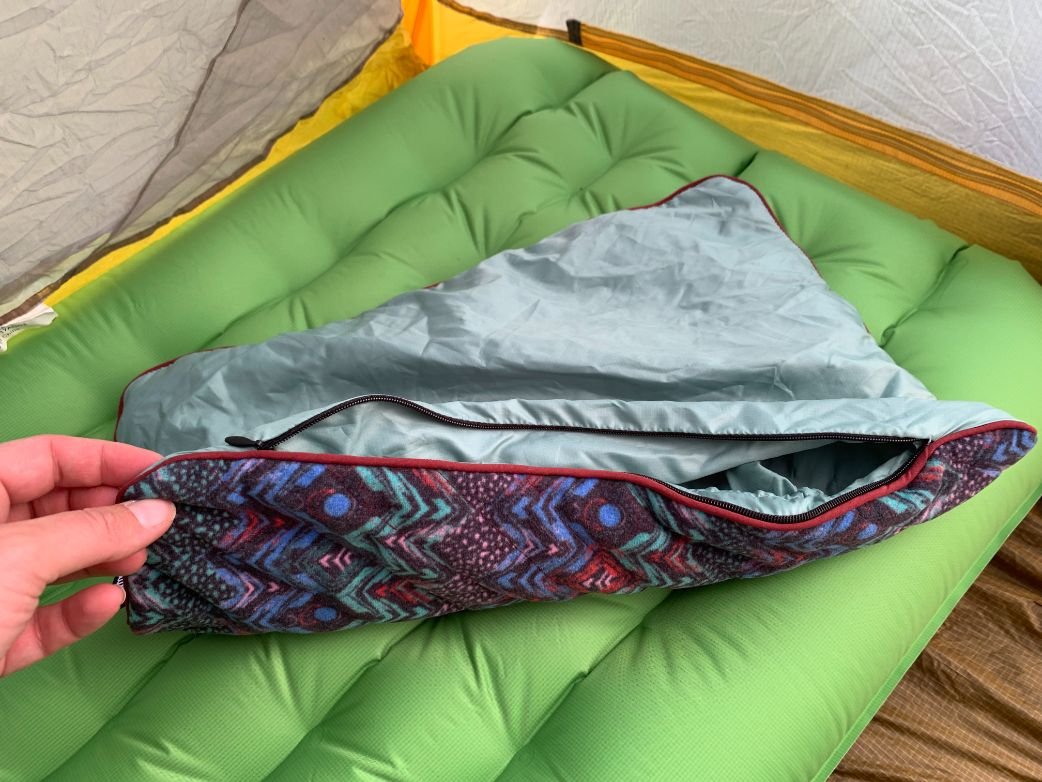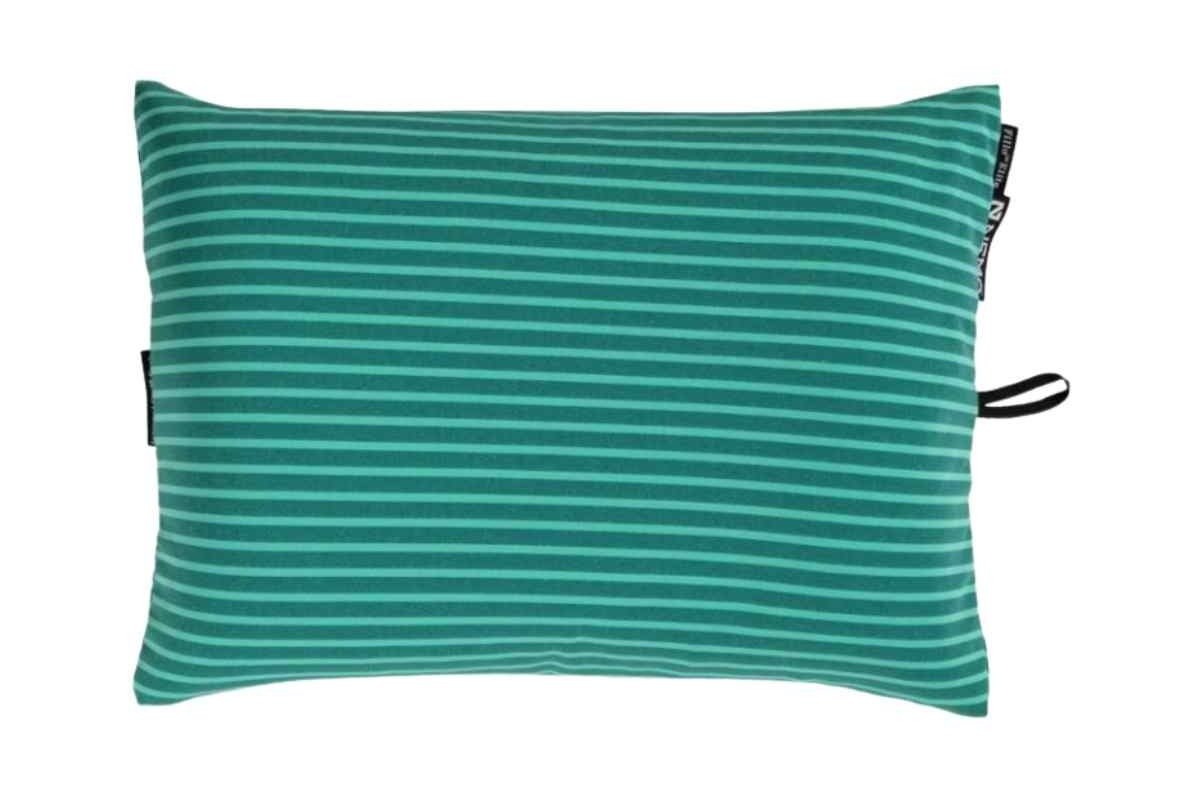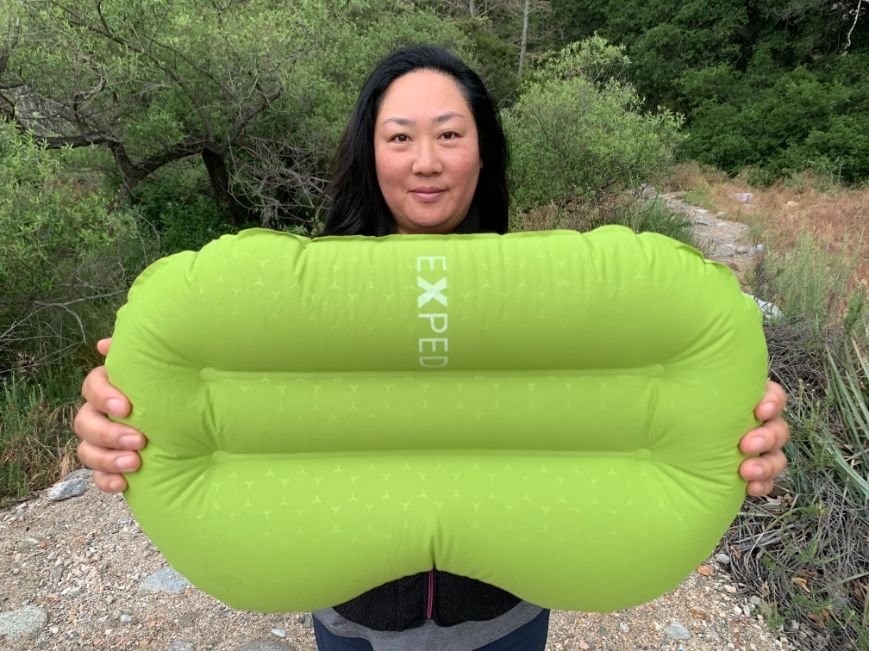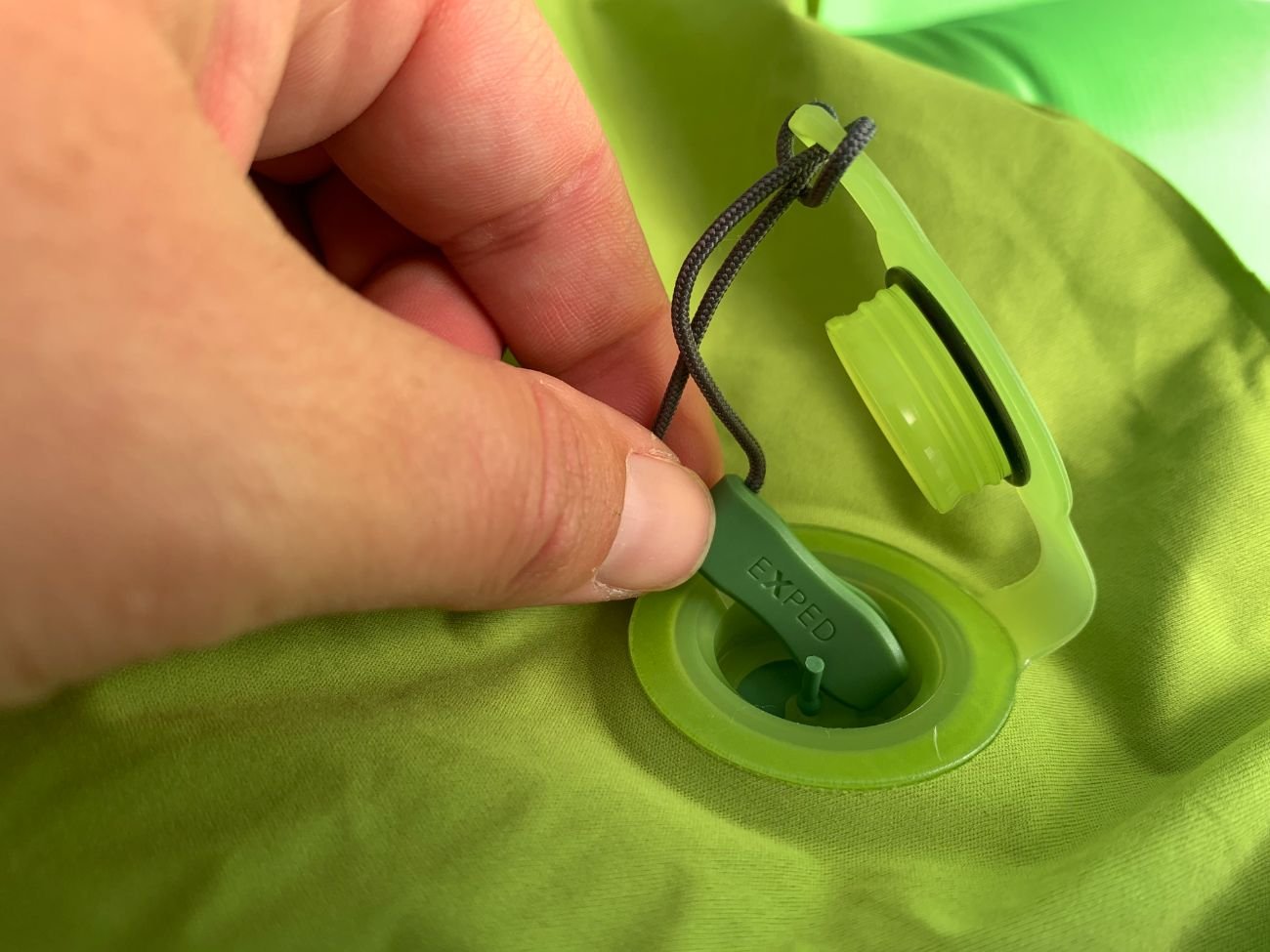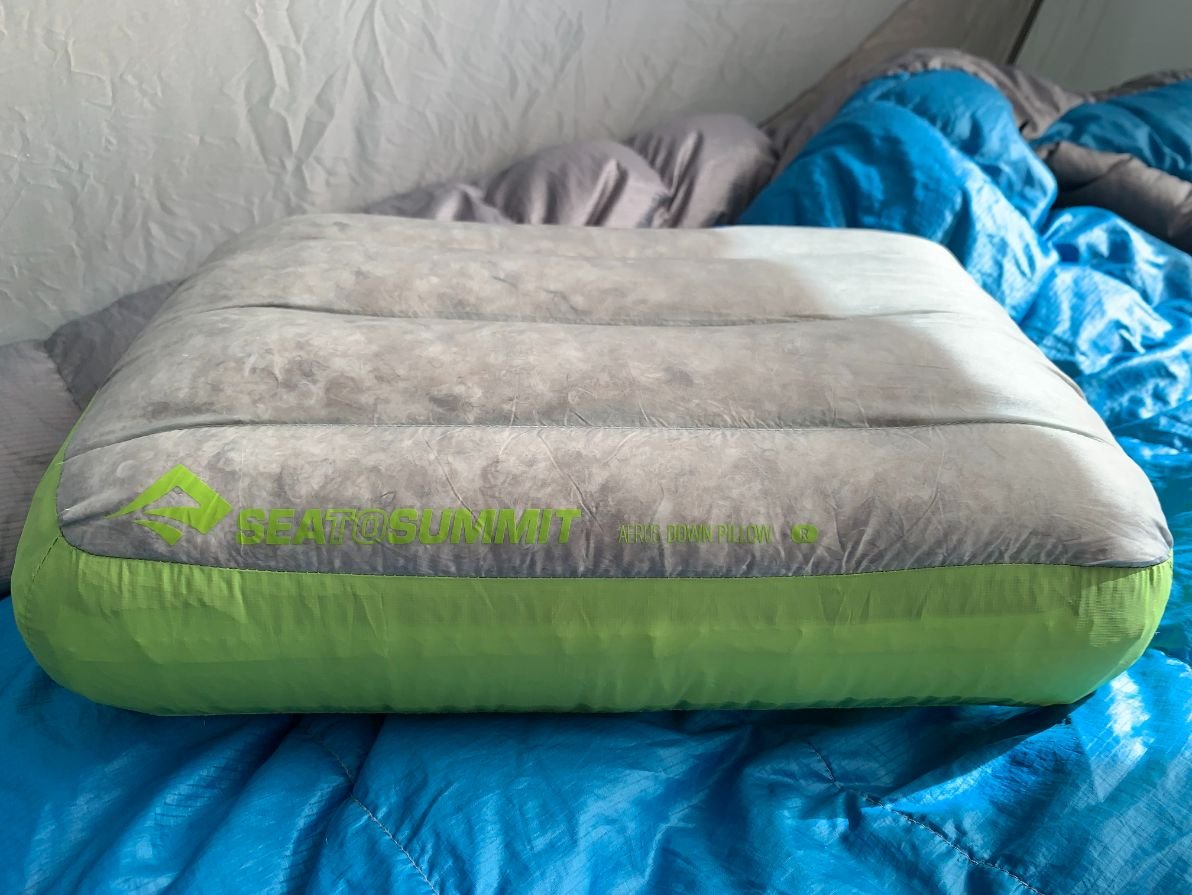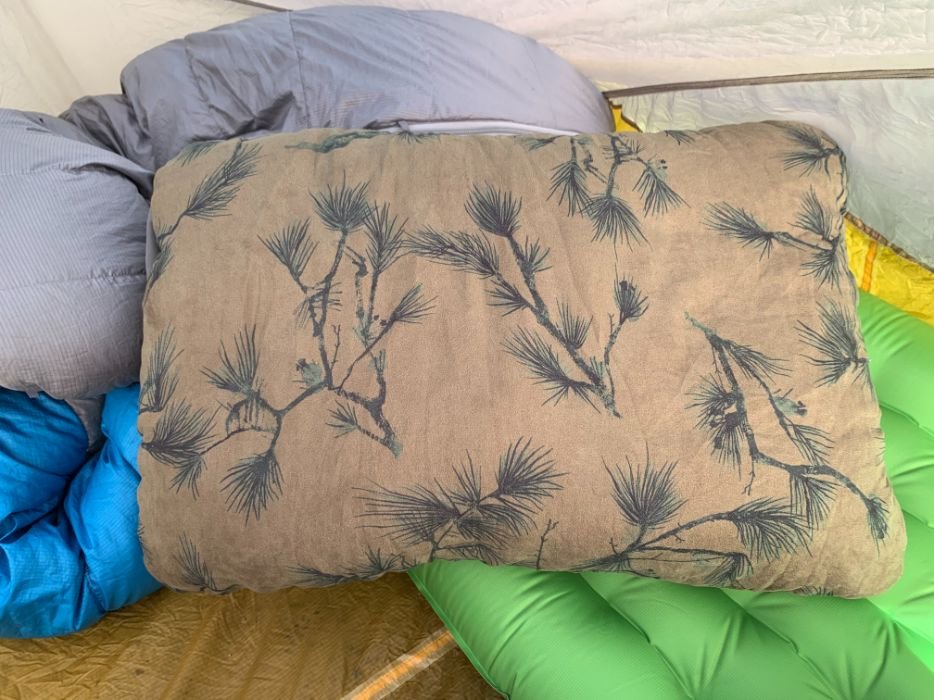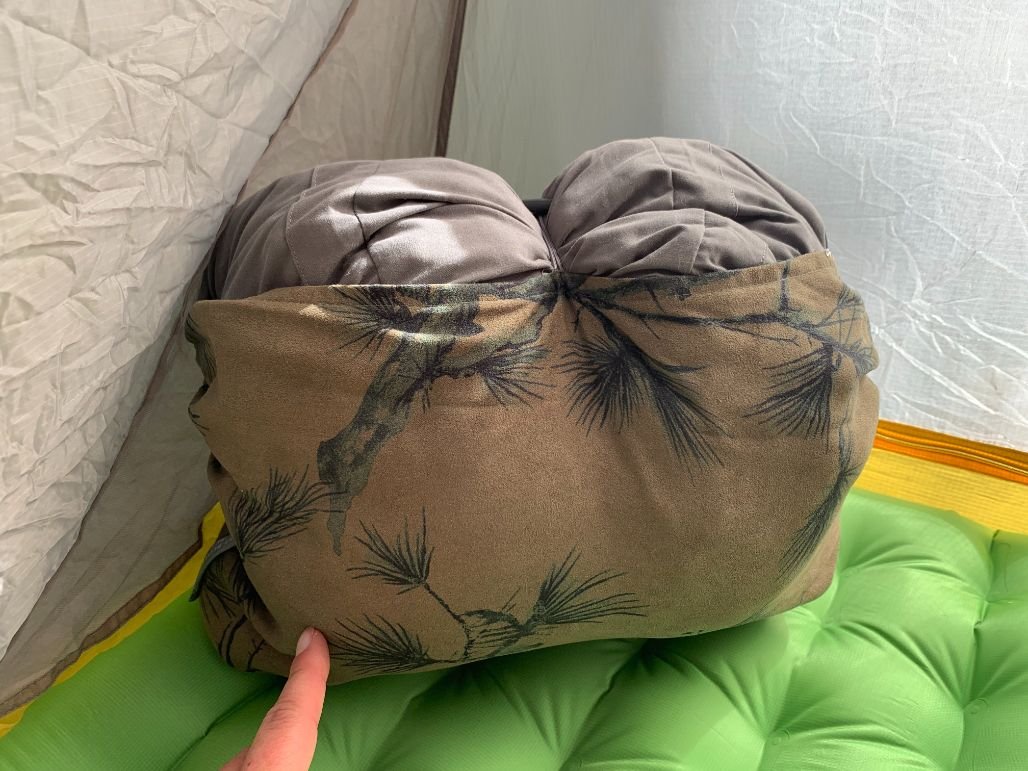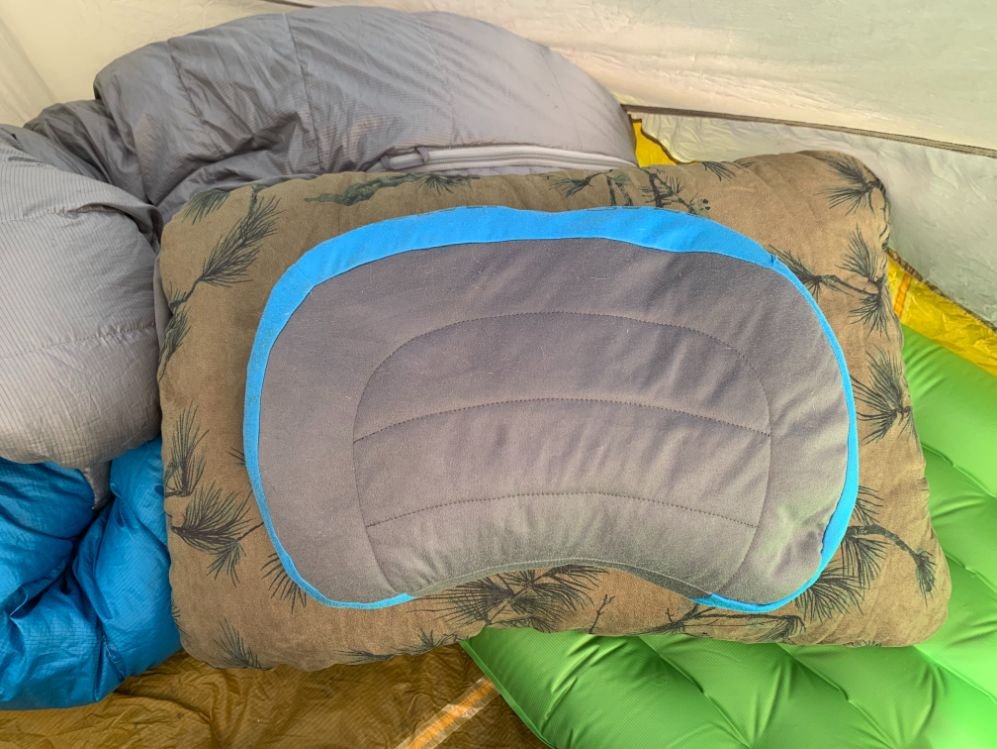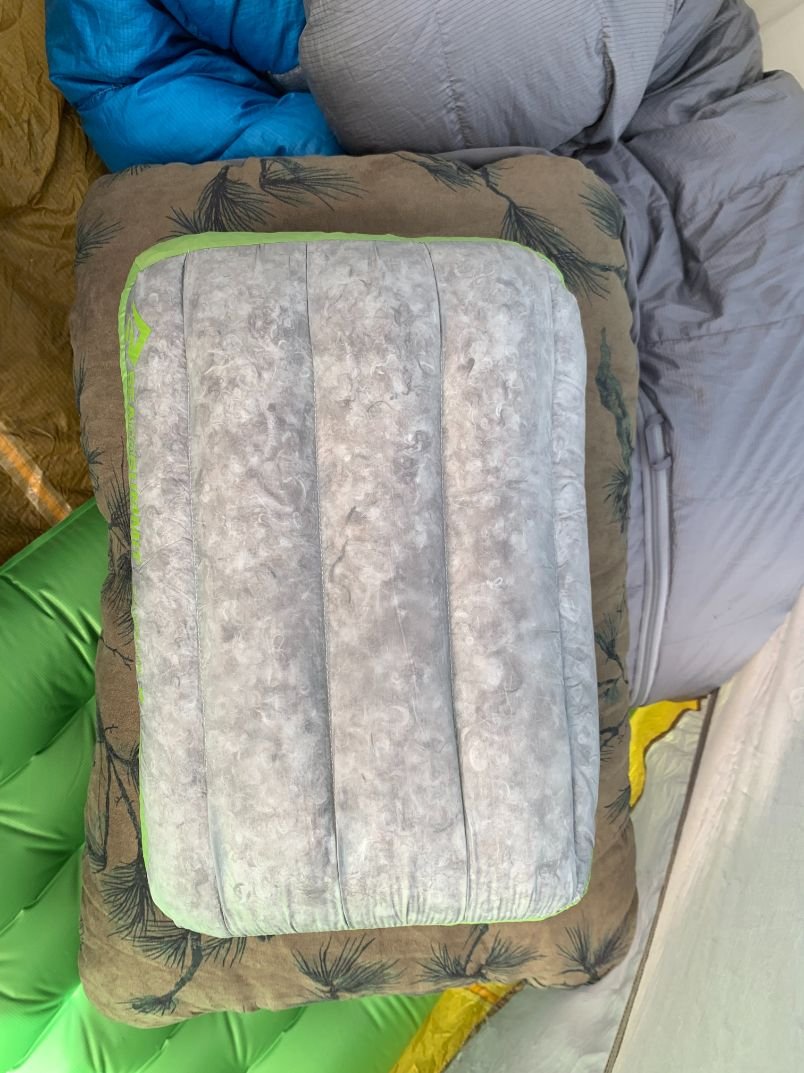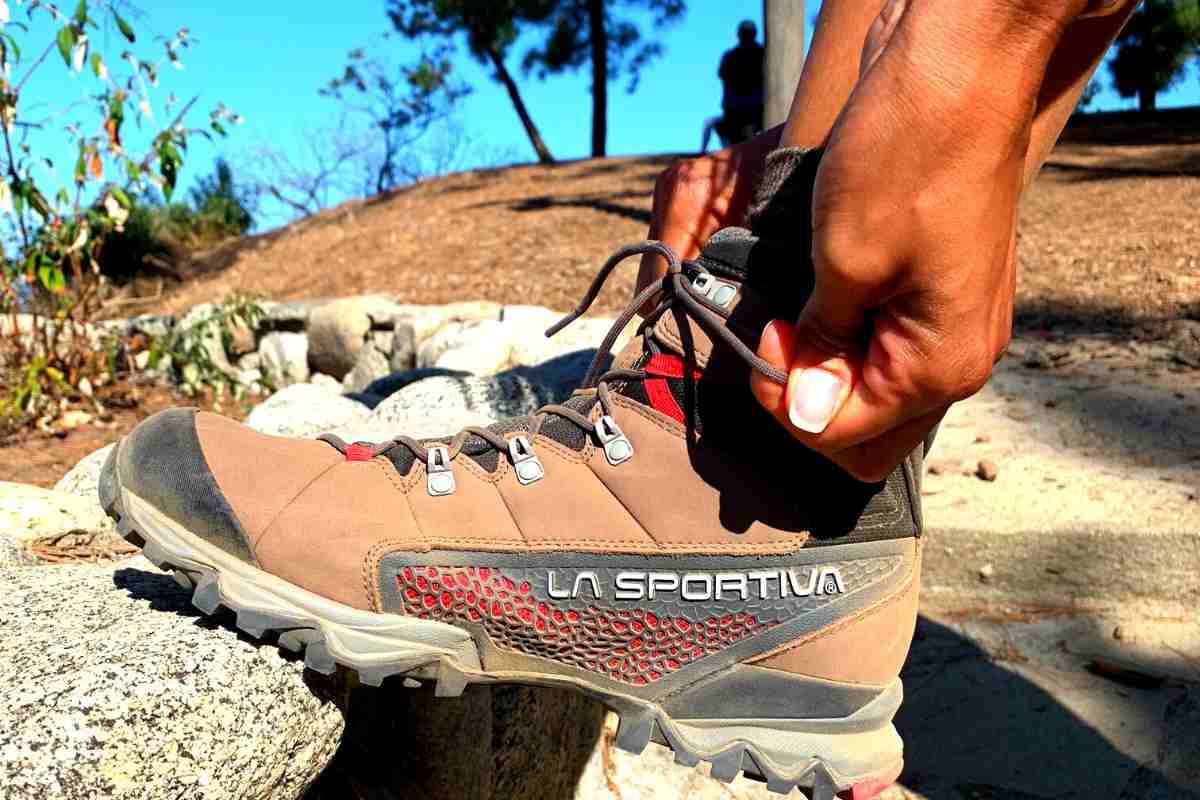Best Backpacking Pillows of 2024
From ultralight inflatable camp pillows to the most comfortable, these pillows are the best we've found
May 23rd, 2024. Updated to include two new pillows we tested by HEST.
Home > Gear Reviews > Camping
Some backpackers consider pillows a single-purpose luxury item that can be replaced by a multi-use stuff sack packed with extra clothing. However, I rest firmly (and, as it turns out, soundly) in the pro-pillow camp.
I’m not just a side sleeper but also a rowdy sleeper, flipping around like a salmon at home and in the backcountry. I also tend to wear my down jacket to bed, relegating my “extra” clothes to a lightweight rain jacket and sweat-soaked, dirt-stained trail garb, hardly the stuff I want lingering close to my nostrils at night. On top of all that, I developed arthritis in my neck due to injuries sustained during a car accident. For me—and many others—a good night’s sleep on the trail requires a camping pillow.
When my favorite backpacking pillow (more on this shortly!) sprung a leak after nearly a decade of use, I set off on a mission to find its replacement. We sorted through the most popular backpacking and camping pillows and put nearly a dozen of them to the test. Testing included short and long stints on the Pacific Crest Trail, Colorado Trail, Backbone Trail, North Lake-South Lake Loop, California Riding and Hiking Trail, choose-your-own adventures in Joshua Tree, international travels, car camping trips, and beyond.
It’s safe to say that I have a pretty good idea of which one will accompany me on future human-powered adventures (and, let me tell you, the answer proved somewhat surprising, as you’ll find out just below). Hopefully, all this time spent curling up in the name of sleep also helps you rest more soundly on the trail.
All specs and prices listed are for any given pillow's “regular” or “medium” size, if multiple sizes exist.
We create reader-supported, objective gear reviews independently selected by our editors. This story may contain affiliate links, which help fund our website. When you click on the links to purchase gear, we may get a commission, without costing you an extra cent. Thank you for supporting our work and mission of outdoor coverage for every body! Learn more.
Comparison table
| PILLOW | TREELINE AWARD | TYPE | COMFORT | WEIGHT | DIMENSIONS | PACKED SIZE | SUPPORT | EASE OF USE | MSRP* |
|---|---|---|---|---|---|---|---|---|---|
| Sea to Summit Aeros Premium | Best Overall Read why |
Inflatable, with lightly padded top | Excellent | 2.8 oz | 13.4 x 9.4 x 4.3" | 2.8 x 3.3" | Excellent | Excellent | $50 |
| Nemo Fillo | Most Comfortable Read why |
Inflatable, with foam top | Excellent | 9 oz | 17 x 11 x 4" | 4 x 6" | Excellent | Good | $45 |
| Sea to Summit Aeros Ultralight | Best Ultralight Read why |
Inflatable | Average | 2.1 oz | 14.2 x 10.2 x 4.7" | 2 x 2.8" | Good | Excellent | $44 |
| ExPed Megapillow | Best for Side Sleepers Read why |
Inflatable, with padded top | Excellent | 6 oz | 20.9 x 12.6 x 4.7" | 3.9 x 5.1" | Excellent | Good | $60 |
| Rumpl Stuffable Pillowcase | Best Stuff Sack Upgrade Read why |
Stuff sack with lightly padded top | Good | 3.2 oz | 16 x 11" | 3 x 6" | Variable | Excellent | $40 |
| Therm-a-Rest Air Head Down | Best Insulated Read why |
Inflatable, with padded top | Good | 4.9 oz | 15.5 x 11 x 4" | 3.5 x 5" | Good | Excellent | $60 |
The Winners
Best Overall Backpacking Pillow: Sea to Summit Aeros Premium
Weight: 2.8 oz
Shape: Lima bean (mummy-bag compatible)
Size: 13.4 x 9.4 x 4.3"
Type: Inflatable
Best for: Backpackers who want to go light without sacrificing too much comfort
What we liked: Curved shape is supportive, good height, packs small, relatively lightweight, soft against skin, flat valve system for easy adjustments, fits into mummy bag hood
What we didn't like: Price is higher than some other options, not machine washable
Sea to Summit’s Aeros Premium Pillow isn’t just our overall pick for most backpackers—it’s also the beloved pillow I was trying to beat when I began this testing process. Yes, that means that after checking out a bevy of other options, some lighter, some cushier, I still think that the overall combination of a reasonably small packed size, a light weight, a somewhat mid-range price, support, adjustability, ease of use, and comfort makes this an excellent choice for most people who want to use a pillow while backpacking.
Compare Prices Of The Sea To Summit Aeros Premium
The Sea to Summit Aeros Premium offers support, adjustability, ease of use, and comfort.
As I mentioned in the introduction, I used my original Sea to Summit Aeros Premium pillow for close to a decade before it sprung a leak. During that time, I carted it along on the Pacific Crest Trail and Colorado Trail, along with endless trips in the Sierra, the desert, national and state parks across the southwest, and countless other overnighters.
I also used the Aeros Premium in all four seasons, including some gnarly winter backpacking in the alpine. If I’m being honest, I probably didn’t hand-wash the thing until it had close to a thousand miles on it, but it never felt or looked terribly grubby before then (although the rinse water told a different story).
I’m also fairly rough on my gear and never once used the included stuff sack on a trip; instead, I shoved the pillow in with my sleeping bag or tucked it into a cavity elsewhere in my pack. The fact that it took ten years before I finally punctured my Aeros Premium speaks volumes—and the fact that Sea to Summit hasn’t changed much about the pillow in all of those years says even more.
The soft fabric on the Aeros Premium means a pleasant night of sleep, yet is is durable enough to last (in our experience) nearly a decade.
Much like its lighter sibling (the Aeros Ultralight), along with ExPed’s Ultra Pillow and Therm-a-Rest’s Air Head Down, the Sea to Summit Aeros Premium is shaped like a lima bean, with a curved underside meant to cradle your head, neck, and shoulders and theoretically keep the pillow with your body as you wiggle around in the night. That shape, coupled with a thick 50D brushed polyester exterior (something the other pillows lack), makes this one of the less-slippery options out there, although just about any air pillow will have some trouble staying put on a slick blow-up mattress if you keep it fully inflated.
The Aeros Premium also fits perfectly inside a mummy hood, solving the vanishing pillow issue. Better yet, it utilizes Sea to Summit’s proprietary PillowLock system, which allows pairing with the brand’s air mattresses via velcro-esque adhesive strips that you can tack to their surface. Pro tip: You can replicate this system with any air mattress if you choose a finely looped adhesive velcro. (Friction keeps the pillow in place, not any sort of brand-specific magic).
The lima bean shape and the thick brushed polyester make the Aeros Premium one of the least-slippery pillow options out there.
That same brushed polyester cover that gives the pillow its velcro-stick quality also gives the Aeros Premium a luxe, almost-microsuede feel boosted by a light layer of polyfill underneath. The key is to let a little air out so the pillow feels less bouncy under your head. This pillow (and all of Sea to Summit’s offerings) really shines in this area, thanks to a dual flat valve system that not only lays fairly flush against the pillow but also allows for micro-adjustments when you lightly press a small button on the inner valve. The valves are unobtrusive but very easy to use, even when lying on the pillow at night.
The Aeros Premium’s height also comes out toward the top of our stack, with a 4.3” loft bested only by its siblings and ExPed’s huge Megapillow, making it an excellent choice for side sleepers. As a bonus, Sea to Summit also has a pretty extensive warranty, repair, and parts replacement program that guarantees against “defects in materials or workmanship for the lifetime of the product.”
We found the dual inflate-deflate valve of the Sea to Summit Aeros to be among the most intuitive and easy to use of the inflatable pillows.
Of course, no pillow is perfect, nor is every pillow perfect for all people. It’s a little pricier and slightly heavier than some other options, and some people prefer a bigger, rectangular shape to better mimic their home favorite. If you want a bit more pillow, the large Aeros Premium adds just 1.2 oz in weight, a hair over 3” in width, and 0.8” in height, which can help improve comfort.
Otherwise, my biggest gripe is that I wish the cozy cover were removable and machine washable. Still, it’s not terribly difficult to clean; I actually prefer to leave it fully inflated, using gentle soap and warm water, scrubbing with my fingernails and rinsing repeatedly before letting the air out and draping it over a clothesline to dry.
As it turns out, we’re not alone in loving Sea to Summit’s Aeros Premium pillow. GearLab named it their 2023 Best for Backpacking pick. Clever Hiker calls it their Best Ultralight Pillow; Greenbelly joins us in awarding it Best Overall Backpacking Pillow, and The Trek calls it “life-changing.”
The Lima Bean shape on the Aeros Premium pillow holds the neck in place. It’s also an ideal height for supporting the head without straining the neck.
Nearly all these reviews mention the same factors we love: the small packed size, generous loft, softness against the skin, easy-use flat valve system, and light weight. Reviewers on consumer sites like REI and Amazon heaped similar praise, with only a few negative reviews mentioning air leaks and general discomfort, issues brought up by a subset of purchasers with nearly all of the inflatable pillows we mention in this piece.
While I did come away from this pillow review process with some other favorites, I can’t say I’m too surprised that the Sea to Summit Aeros Premium remains a top contender. Because of its relative comfort, small size, light weight, and durability, I’ve recommended it to friends, to my students in outdoor skills classes, and to participants on trips that I’ve led in the backcountry—and I’ll continue to do so for a long time to come.
Most Comfortable Backpacking Pillow: NEMO Fillo
Weight: 9 oz
Shape: Rectangular
Size: 17 x 11 x 4”
Type: Hybrid
Best for: Backpackers who value true comfort over weight savings
What we liked: Soft jersey cover, hybrid construction means that it’s incredibly soft and pliable while still maintaining loft, soft support, machine washable cover
What we didn't like: Very heavy for backpacking, bulky when packed up, fidgety valve
I began testing the NEMO Fillo during the desert backpacking season, so I hauled it out to places like Joshua Tree National Park and Anza-Borrego Desert State Park—but I’d be lying if I didn’t admit that it’s gotten even more use in my bed. A few days before taking the Fillo on its maiden voyage, I blew it up for a quick tester…and then slept on it for several nights at home.
I don’t typically cuddle up with backpacking pillows at home, but the Fillo’s hybrid design—a thick slab of foam that rests on top of an air bladder, all swaddled up in an impossibly soft pillowcase-like cover—makes it shockingly comfortable. If you’re willing to sacrifice a little bit of pack space and a few extra ounces by hauling NEMO’s Fillo in your pack, you’ll be handsomely rewarded with a deeply cushioned, ultra-cozy, downright luxurious slumber.
Compare Prices Of The Nemo Fillo
The author with the Nemo Fillo (left) and Nemo Fillo Elite (right).
Treeline Review editor Liz Thomas sleeping on the NEMO Fillow.
We also tested Therm–a-Rest’s extremely popular Compressible Pillow Cinch, a foam-stuffed behemoth that’s even more akin to the pillow you probably sleep with at home. While its microsuede-feel cover, size (13 x 18”), and height (6”) make the Compressible Pillow Cinch a shoo-in for this category, it’s extraordinarily bulky and not at all well-suited for backpacking; the Fillo is leagues more compressible, even though it’s just 0.1 oz lighter.
The Fillo’s hybrid design allows for incredible adjustability. Like other inflatables, the twist-lock valve allows for adjustments to the air pressure.
You can also pull the foam slab out of the pillow (or even slice it in half) and use it as a lower-volume inflatable. You can remove the air bladder and use it as a foam pillow. You can also use the machine washable, ultra-silky, jersey-like cover as a luxurious stuff sack-style pillow case—although that kind of defeats the purpose of the hybrid setup.
The NEMO Fillo is firm when fully inflated, although not as wobbly as strict inflatables. When you let a little air escape, however, the Fillo reaches its full potential and feels shockingly like a home pillow, rectangular shape and all.
Close up on a de-constructed NEMO Fillo to reveal the foam. The outer material pillow case is on the right.
The foam acts as a light memory foam, allowing your head to sink in slightly, which helps to keep your pillow in place, a stark difference from strict air bladder pillows.
The Fillo’s 4” height isn’t the tallest of our bunch, but it was supportive enough for me to sleep on my side comfortably. The foam topper also helped the Fillo feel the most comfortable of any pillow in our sampling while I was sleeping on my stomach. Another bonus—if any part of the pillow fails, it’s covered by NEMO’s Lifetime Warranty; the brand also offers a repair service.
Any pillow this comfortable will come with some tradeoffs, namely in its weight (it was the second-heaviest, only behind the Therm-a-Rest Compressible Pillow Cinch) and packability (it’s a bit difficult to smoosh into the attached stuff sack), taking up a little less space than a Nalgene when compressed—you can thank the cush foam for that extra bulk. The twist-lock valve feels more fiddly than some other options, requiring a two-step process (twist, then push down) to lock air inside or release it.
Close-up on the valve on the NEMO Fillow.
The Nemo Fillo compresses into the attached stuff sack (the black fabric) and has a soft surface (the blue).
Some users report that the bottom of the pillow is slippery, although we didn’t find this to be the case, especially after letting out a small bit of air. Finally, the padding does emit some “off-gassing,” a chemical smell that is typical of newly unpackaged memory foam; we found that this odor dissipated when the pillow was inflated and left to breathe for a few days before use.
Plenty of professional reviewers agreed with our assessment of the NEMO Fillo. Outside named it one of the “5 Pillows We Love,” Backpacker touted it as “an inflatable pillow that feels like the real thing” in 2010, and even CNN jumped into the fray, naming it as one of their Best Camping and Backpacking Pillows. GearLab has long given the Fillo high marks and named it their Best Overall Camping Pillow pick for 2023, especially for its comfort, support, and ease of use; like they said, “We’ve simply exhausted ourselves searching for a pillow that can compete.”
Amen! I’ll admit that I balk at the thought of carrying a 9 oz. pillow for long-haul backpacking trips—but you better bet the NEMO Fillo will find its way into my pack for shorter jaunts, where a good night’s sleep makes the next day’s adventures sweeter.
Best Ultralight Backpacking Pillow: Sea to Summit Aeros Ultralight
Weight: 2.1 oz
Shape: Lima bean (mummy-bag compatible)
Size: 13.4 x 9.4 x 4.3
Type: Inflatable
Best for: Ultralight hikers who prefer an inflatable to a stuff sack
What we liked: Very lightweight, tiny pack size, good height for side sleepers, center baffles that help cradle the head
What we didn't like: A little more slippery and crinkly than pillows with fabric covers, not as soft against the skin as pillows with more luxe material, not machine washable
I suppose I shouldn’t be surprised that Sea to Summit’s Aeros Ultralight felt as comfortable as it did, considering my overall positive experience with the Aeros Premium. It comes in the same lima bean shape, but the loft is actually 0.4” higher than the Premium, making this one of the tallest hiking pillows we tested and an excellent option for lightweight backpackers who are side sleepers and who won’t want to carry the heavier ExPed Megapillow, our decidedly plush winner in that category.
Compare Prices Of The Sea To Summit Aeros Ultralight
The author holding up the Sea to Summit Aeros Ultralight on a backpacking trip in Joshua Tree National Park.
Surprisingly, the Ultralight ended up besting the ExPed Ultra Pillow, despite the latter coming in about 0.3 oz lighter. Both pillows feature similar dimensions and a similar feel against the skin. Still, the Aeros Ultralight’s valve system—the same one on the Aeros Premium—is easier to use. Its interior baffles feel more ergonomic than the ExPed Ultra’s, which are set incredibly deep, causing a noticeable neck tilt when resting your head in the middle.
The Sea to Summit Aeros Ultralight is a minimalist pillow that offers surprising comfort.
The Sea to Summit Aeros Ultralight is a great option for ounce-shaving backpackers who crave nighttime comfort but don’t enjoy cuddling up with their stuff sack. The pillow packs up tiny; its 2 x 2.8” dimensions are the smallest in our entire lineup. The 20D stretch polyester cover is brushed on the backside (making it compatible with Sea to Summit’s PillowLock system). The topside is lightly flocked, giving it a better feel against the skin than you might imagine for a minimalist pillow.
Another tester holding up the Sea to Summit Ultralight. The Sea to Summit Ultralight has a lima-bean shape to more easily fit into a mummy bag with comfortable divots to hold the head.
Here, too, it beats the ExPed Ultra, which uses a similar 20D stretch polyester fabric not just on the top but also on the bottom, making it more slippery when used directly on an inflatable mattress (although the Ultra does feature attachment points on either side, where users can rig cord or other material to loop their pillow around their pad to keep it in place).
The Sea to Summit Aeros Ultralight uses a grippy material on the bottom that reduces slippage on a sleeping pad. It features the same two-way valve we liked on the Sea to Summit Aeros Premium.
There is a bit more of a crinkle sound with the Aeros Ultralight versus the Premium, given that this pillow lacks the latter’s soft cover. Another slight ding is that due to the manufacturing design, there’s a strip of fabric around the Ultralight’s entire exterior where the seams were welded together. It’s not terribly scratchy or obtrusive, but it’s not as smooth as covered pillows like the Aeros Premium; you may want to slip a buff around the Ultralight to create a softer surface overall. You also can’t machine wash the Ultralight, although hand-washing is simple enough.
The Sea to Summit Aeros Ultralight received reasonably high marks across the board from professional reviewers and users alike. Gear Junkie named it their Best Inflatable Camping Pillow for 2023, giving high marks for its weight, packability, and compatibility with Sea to Summit air mattresses. Switchback Travel listed it as their Best Lightweight Pillow for Backpacking, although they did mention concern about the durability of the thin shell material.
The Sea to Summit Aeros Ultralight compresses down to a small size.
Of course, this lighter material contributes to its low weight, so the tradeoff is just being more thoughtful with where you use it and how you’re packing it away. In a rare outdoor gear mention in New York Magazine, a reviewer gave the Aeros Ultralight high marks for portability, not just for backpacking but for general travel.
The more I test it, the more I believe Sea to Summit’s Aeros Ultralight is the exact right balance of weight and comfort for a month-long backpacking trip I’ll undertake later this summer and for anyone undertaking a trip of any length who wants to keep pack weight low while bumping up the nighttime comfort factor a notch or two.
Best Pillow for Side Sleepers: ExPed Megapillow
Weight: 6 oz
Shape: Rectangular
Size: 20.9 x 12.6 x 4.7”
Type: Inflatable
Best for: Side sleepers who don’t mind toting around a larger, heavier pillow for better sleep, car camping
What we liked: Excellent height, plush cover material, washable cover, support
What we didn't like: Bulkier than other inflatables when packed, on the heavier side, too large for sleeping bag hood, expensive
As a side sleeper and person with arthritis, I need a backpacking pillow with the proper height to support my head and neck; otherwise, I’ll spend the night in an endless cycle of shoving my arm under my pillow, then yanking it out once it goes numb. Enter the ExPed Megapillow, the luxury yacht of backpacking pillows with a nearly 21” wingspan, a massive 4.7” loft, and a downright plush microfiber topper. It’s designed to be paired with the brand’s cush MegaMat sleeping pad, but honestly, it can be used on any pad (so long as you’re ready for a ridiculously comfortable night). Although we don’t have a category for best pillow for car camping, this plush pillow would be a contender.
Compare Prices Of The Exped Megapillow
The ExPed MegaMat pillow is a luxurious inflatable pillow.
Sure, the Megapillow’s 6 oz weight is near the top of what I’d consider reasonable for a comfortable night of sleep in the backcountry. But then again, I’ve never slept as soundly in the backcountry as I have on this big, soft boat of a pillow. For its height, size, and packability factor (which is not great but is still leagues better than the incredibly bulky Therm-a-Rest Compressible Pillow Cinch, the only pillow we tested that surpassed the Megapillow’s loft), side sleepers have plenty of reason to believe that a few extra ounces of cure are worth a pound of solid rest.
One day when I was bored, I pulled out a measuring tape to log the optimal distance from the base of my head to a pillow surface. It came out to a solid 4”, a height that most of the backpacking pillows on our list reach handily. But here’s the thing—most of those are inflatable pillows, which you’ll want to deflate a bit to reduce the sleeping-on-a-balloon feel; you lose some of that promised loft. The ExPed Megapillow joins Sea to Summit’s Aeros Ultralight and Down offerings at an impressive 4.7”, meaning there’s room to tone down the bubble factor in each.
Where the Megapillow beats both of those, however, isn’t just in size but, more importantly, in overall comfort and support. Instead of its sides tapering into a ribbon of excess fabric or forming a slippery curve as the others do, the Megapillow has a mostly vertical edge covered in a cozy, lightly stuffed microfiber topper. What’s also nice is that even fully inflated, there’s a surprising amount of give in the pillow, likely thanks to its expansive size. I didn’t feel the need to deflate this as much as I do with smaller, curved pillows.
On a similar note, I stayed on top of this pillow the entire night, and it stayed on my pad. The ExPed Megapillow is built with loop attachment points on either side, so you can use string, elastic, cord, or something similar to connect it to your sleeping pad to ensure it stays put. Unlike some of the other pillows we’ve reviewed, the Megapillow’s soft cover is removable and machine washable, another check in the plus column, no matter how you sleep.
It’s hard to beat the comfort of the ExPed Megapillow.
That cozy cover is made from a 50D stretch tricot polyester and topped with a fleece-like, proprietary Texpedloft microfiber. The Megapillow’s polyester is Oeko-Tex 100 certified, which means that it doesn’t contain any components known to be harmful to humans. The microfiber is Bluesign certified, meaning it’s crafted in the most sustainable way possible, following strict guidelines set for the textile industry. ExPed is a MyClimate Climate Neutral company, which means they utilize carbon offsets, and they are working toward being fully PFC-free by 2025.
ExPed also offers a five-year warranty. It’s not the “lifetime” promise that other brands tout, but their repair service is affordable and responsive, something I discovered when I sprung a leak on my beefy ExpEd Synmat after an incident during a winter backpacking trip that may or may not have involved an errant crampon.
The MegaPillow is so big, it can almost double as a camping body pillow or as something to stuff under knees at night for extra comfort.
At the end of the day, true ultralight enthusiasts—side sleepers or not—aren’t going to haul the Megapillow along for their next thru-hike. It’s also not the most packable, occupying roughly 3.9 x 5.1” inside its stuff sack, nor does it fit inside a mummy bag hood, and it’s one of the most expensive pillows we reviewed. And while it’s nice that the pillow comes with a flat valve system, it’s not quite as intuitive to use as the Sea to Summit double-valve, “button”-adjust system; the Megapillow (and the Ultra) come with an attached dongle that you shove into the valve opening to deflate properly, which is a bit awkward.
For comfort-seeking, backpacking side sleepers, however, all of that is trivial when considering a good night’s rest. During a testing trip in Anza-Borrego Desert State Park, I carried a handful of pillows, each of which I deployed before getting into my sleeping bag—but I was reluctant to swap any of them in to replace this beefy hunk of ultra-supportive cush. The next morning, I realized that I had enjoyed the rare experience of sleeping through the night and waking up without a crick in my neck, making the Exped Megapillow worth its weight in, um, polyester.
Best Stuff Sack camping pillow Upgrade: Rumpl Stuffable Pillowcase
Weight: 3.2 oz
Shape: Rectangular
Size: 16” x 11”; height is variable
Type: Pillowcase
Best for: Travelers, people who want a more comfortable alternative to a stuff sack
What we liked: Soft padded cover, adjustability, use of recycled materials
What we didn't like: Bottom material is slippery, heavier and bulkier than using a stuff sack, pricey for what’s essentially a fancy pillowcase
I am not a huge fan of the stuff sack camping pillow as a category, although I do love having one less thing to inflate at night. As I’ve already mentioned, I have arthritis in my neck and require more support from my camp pillows. I also tend to sleep cold and wear my puffy to bed, which leaves me with very little clothing to fill the sack. All of that said, Rumpl’s Stuffable Pillowcase might just make me a believer. Designed less for gram-counters than for comfort-seekers, this zip-up case is relatively lightweight and big on comfort, a perfect combination for people who can’t stand inflatables, who don’t want to haul around a bulky foam-filled pillow, and who hope to cush up their backcountry slumber a bit while saving some cash.
To give the Rumpl Stuffable Pillowcase a fair shake, I doffed my down jacket during a decently warm night while backpacking in Joshua Tree, adding a lightweight rain jacket to the stuffing for a bit more bulk. Laying down, I initially missed the loft of taller, firmer pillows—but then, oh, the softness! The quilted, fleecy topside is lightly filled; surprisingly, the whole thing felt like a smaller version of my home pillow.
Compare Prices Of The Rumpl Stuffable Pillowcase
The author resting on the Rumpl stuffable pillow case on a recent backpacking trip.
The stuff sack pillow is the one made by shoving your jacket or clothing inside a stuff sack that previously contained, say, your sleeping bag. This pillow is the ultimate example of the dirtbag backpacker maxim that most items in your pack should have at least two uses. Unless you’re springing for an expensive, purpose-built pillow-top stuff sack like Zpacks microfleece-lined Medium Pillow or Hyperlite Mountain Gear’s extremely similar Stuff Sack Pillow, you’re stuck with what’s likely to be a very slippery, uncomfortable sleeping surface. My experience with the Rumpl was different.
Stuffing a down jacket into the Rumpl Stuff Sack.
My favorite use for the pillowcase, however, is for travel. I flew to Mexico City earlier this spring and threw the Rumpl in my carry-on at the last minute. When I grew drowsy during my flight, I shoved a sweater in there and settled in for one of the comfier naps I’ve taken on a plane. I also realized that the Stuffable Pillowcase would work well as extra storage if I brought home a few extra items—I could just stuff it with clothes, put the extra items in my now-roomier suitcase, and carry the small pillow on the plane. Bonus!
Rumpl’s design departs from the traditional stuff sack pillow in several ways. First, it’s a zip-up pillowcase (hence the name), which tucks inside of an attached stuff sack (Inception-level stuff here!). The nice thing about the zipper versus a toggle-style cinch found on DIY stuff sack pillows is that it won’t accidentally loosen at night. The Stuffable Pillow also differs from generic stuff sacks in that it has an exceptionally soft top side made with quilted, recycled fleece. While the Zpacks microfleece-lined Medium Pillow and Hyperlite pillow stuff sacks feature soft sleeping surfaces, they’re not padded and are significantly more expensive.
The Rumpl Stuffable Pillow compresses to a small size when not in use.
Of course, like a traditional stuff sack, the Rumpl Stuffable Pillow is highly customizable. You simply shove in as much or as little as you’d like to fill it to the desired height and capacity. It’s also machine washable; I chucked it in the washing machine after a recent trip, and it cleaned up just fine.
Another winning factor for the Stuffable Pillow is that Rumpl prioritizes sustainability in their goods. They are a certified B Corporation, Climate Neutral Certified (conducting annual check-ins to measure their carbon footprint and using multiple offsets), and a member of 1% for the Planet, donating one percent of their profits to environmental non-profits. The Stuffable Pillow displays this ethos with a 100% post-consumer recycled ripstop polyester underside, a topper made from 100% post-consumer recycled polar fleece, and synthetic insulation that includes roughly six recycled plastic bottles.
The zip on the Rump Stuffable Pillow allows for adjustability.
The Rumpl Stuffable Pillow’s weight is similar to some inflatables, although positive reviews—and our experience—agree that when stuffed to your liking, it’s more comfortable than most inflatables unless you prefer a sturdier pillow. The underside is made from a 30D ripstop polyester that is a bit slippery, but that is somewhat offset because it is less likely to slide around your mat since it’s not a giant bladder filled with air. Finally, while the zippered design keeps your “stuffing” in place, it’s not as useful as a stuff sack when it comes to storing gear in your bag during the day since the quilted exterior will be exposed to dirt while in your bag if it’s not stored in its own sack.
By and large, the Stuffable Pillow is the most-reviewed pillow on REI, with exceptionally high marks from users who mention its softness, portability, machine washability, and usefulness not just for backpacking and camping but for travel as well. Outside named it one of the “5 Pillows We Love,” noting that hot sleepers might like flipping it around to the underside if they need to cool down. In a standalone review, GearLab called it “a fresh take on conquering the three demons that plague every camp pillow design: Acceptable balance between size, weight, and comfort.”
While I’ll personally stick to inflatables on longer trips, I did emerge a changed woman after testing the Rumpl Stuffable Pillow since it marries the adjustability and portability of a stuff sack with the comfort of a home pillow. I’ve lent it to fellow backpackers, and the most recent borrower, an ultralight enthusiast, returned it only reluctantly, saying that he would order one online as soon as he got home. Seems like a win to me!
Best Insulated Backpacking Pillow: Therm-A-Rest Air Head Down
Weight: 4.9 oz
Shape: Lima bean (mummy-bag compatible)
Size: 15.5 x 11 x 4”
Type: Inflatable, insulated
Best for: Lightweight backpackers who are cold sleepers
What we liked: Soft feel against the skin, curved shape, significant insulation, materials felt durable, machine washable cover
What we didn't like: Heavier than some other options, twist valve sticks out of the pillow’s side, pricey
The first time I used the Therm-a-Rest Air Head Down Pillow was almost four years ago during a rafting trip down the Middle Fork Salmon River. Since I wasn’t carrying the pillow on my back, I couldn’t have cared less whether it was big or small, light or heavy—all I cared about was that it kept my head cozy and helped me rest up for the next day’s miles.
However, when I began taking it on shorter backpacking trips, I was a bit more smitten. While it comes in just over 2 oz heavier and doesn’t cinch down as far as my beloved Sea to Summit Aeros Premium, I realized that the curved Air Head Down Pillow was something like its softer, insulated cousin. That extra comfort and warmth, along with the pillow’s curved shape and decent packability, now make it a no-brainer to carry on all my cold-weather trips.
Compare Prices Of The Therm-A-Rest Air Head Down Pillow
The Air Head Down has a soft down cover that adds insulation and feels warm against your face.
The Air Head Down’s biggest contender in our sampling was Sea to Summit’s Aeros Down Pillow—and I’ll be honest, I was sure that the latter would come out on top given not just my positive experience with the brand’s backpacking pillows, but also the fact that it is 2.4 oz. lighter than the Air Head Down and packs down significantly smaller (2.5 x 3” versus 3.5 x 5”). And then I slept on it. And then friends slept on it. And we all agreed—the Aeros Down is just not all that comfortable, given that it’s a small, somewhat bulbous rectangle covered in slippery 10D polyester.
The Therm-a-Rest Air head Down pillow has a removable pillow case that can be washed.
However, our insulated winner’s cover is made from a slightly thicker and much softer partially recycled polyester that feels silky against the skin—and feels leagues more durable than the Aeros Down’s cover material, so whisper-thin that you can see all of the feathers below. The Air Head Down’s curved shape also beats the competition, as it does a better job of cradling your head, neck, and shoulders. While it’s 0.7” shorter than the Aeros Down, I didn’t need to deflate it to feel comfortable, while the former required some serious deflation before my head stopped rolling around on the surface.
Therm-a-Rest’s Air Head Down also comes out on top thanks to a removable and machine washable cover that would work in a pinch as a stuff sack-style pillow if you accidentally puncture the air bladder (although not that it’s likely—this pillow had one of the sturdiest inserts of any we tested). Once I pulled out the bladder, I could easily fit my puffy and light rain jacket inside.
Another positive for the Air Head Down is that its quilted cover is stuffed with 650-fill hydrophobic duck down, a small detail that can help retain its insulating factor if you deal with condensation in your backpacking tent.
The Therm-a-Rest Air Head Down Pillow easily fits inside of a mummy bag.
The inflation valve on the Therm-a-Rest Air Head is similar to that on the Therm-a-Rest NeoAir.
The size and weight, which run middle-of-the-pack, might not entice ultralight backpackers. The traditional twist valve might also disappoint some people who are used to flat valves; that said, it’s never felt obtrusive when in use, and it does make for very easy adjustments to air fill. Another minor irritation is that the stuff sack is a bit tight, but for me, that’s a non-issue during trips since I just shove it in with my sleeping bag.
Gear Junkie named the Therm-a-Rest Air Head Down Pillow their Best Down Insulated pick for 2023, citing its comfort and the fact that it nestles easily into a sleeping bag hood, calling it “lightweight enough for extended backcountry missions but soft and insulated enough to feel like a luxury.” Similarly, GearLab called the pillow their Best for Lightweight Luxury, noting that “when compared side by side, the Air Head Down is more comfortable than the Aeros Down,” a statement with which we heartily agree. Consumer reviews were similarly positive, with thumbs down mostly reserved for its price, among the highest in our sample size.
While the Sea to Summit Aeros Premium remains my all-around workhorse pillow, I’m glad to have Therm-a-Rest’s luxe—and warm—Air Head Down to provide cozy comfort on cold-weather trips.
Other Backpacking Pillows We Tested
Nemo Fillo Elite
Weight: 2.8 oz
Shape: Rectangular
Size: 15 x 11 x 3”
Type: Inflatable
Best for: Back sleepers
What we liked: Soft jersey-feel cover, light weight
What we didn't like: Felt thin, not enough height for side sleepers, fidgety valve
Consider this the kid sibling of the NEMO Fillo: it’s got the same soft, jersey-like cover material, same somewhat fidgety valve, and it’s over 6 oz lighter, but without the height and comfort that the former’s thick foam insert helps provide.
Topping out at a scant 3” when fully inflated, the Fillo Elite comes up (quite literally) short when it comes to providing enough support for side sleepers, in particular—a common complaint among my fellow testers and online users.
Compare Prices Of The Nemo Fillo Elite
The author with the Nemo Fillo Elite pillow in Joshua Tree National Park. The Nemo Fillo Elite is not as thick as other pillows.
It’s a shame because the removable cover is just as cozy as the Fillo’s and just as machine washable, and it’s much closer in weight to some of our other inflatable picks. A small bit of recycled Primaloft filling does add to the luxe feel, as does its generous size—coming in with a length that’s just 2” shorter than the regular Fillo and an identical width.
The ExPed Nemo Fillo Elite fits inside a mummy bag.
The valve on the Nemo Fillo Elite.
I was a bit more comfortable when sleeping on my back, and a jacket shoved underneath added some height to help once I shifted to my side—although it promptly slid out from beneath me since the Fillo Elite is backed with the same somewhat slippery material as its full-size brandmate. GearLab did name the Elite their Best Lightweight Hybrid for 2023, but their highest marks were for the pillow’s packed size, not its overall usability; they also thought it was a bit too thin and docked points for being slightly difficult to shove inside the attached stuff sack.
Weight: 1.8 oz
Shape: Lima bean (small size is mummy-bag compatible)
Size: 15 x 10.6 x 3.9
Type: Inflatable
Best for: Ultralight backpackers who want a little comfort
What we liked: Lightweight, somewhat comfortable against the skin, small packed size
What we didn't like: Somewhat slippery, substantial height differential between edges and middle, slightly awkward valve setup
When I first unboxed the ExPed Ultra Pillow, I thought it was a surefire contender to beat out the Sea to Summit Aeros Ultralight as our Ultralight winner. It is made from a very similar lightly flocked 20D stretch polyester, features a baffled interior, and is a hair lighter (by 0.3 oz) and larger (by 1.6”) than the Aeros Ultralight.
Compare Prices Of The Exped Ultra Pillow
The Expedition Ultra Pillow has a neck shape and deep divots to cradle your head in comfort as you sleep.
Once blown up, however, I noticed that the baffled center was significantly lower than the edges, creating an overinflated bubble around the perimeter. The significant height differential caused my neck to over-tilt when trying to find the middle of the pillow; I ended up sleeping on the edges instead, meaning that my head and pillow moved around all night.
The Ultra Pillow’s valve wasn’t as intuitive as the other pillows we tested.
The Ultra Pillow comes with a dongle that is inserted into the valve cover to keep it open for deflation.
The Ultra Pillow’s flat valve is also not as intuitive as the Aeros Ultralight’s, as it comes with an attached dongle that is supposed to be inserted into the valve cover to keep it open for deflation. Besides its weight (the lightest of our testers), one noticeable upside to the Ultra Pillow is that it comes with loops attached on either end so that you can rig your attachment system to keep it centered on your sleeping mat. This feature is useful, as this pillow lacks the thicker brushed polyester backside that helps the Aeros Ultralight stay in place a little better.
Weight: 2.5 oz
Shape: Rectangular
Size: 13.4 x 9.4 x 4.7”
Type: Inflatable, insulated
Best for: Lightweight backpackers interested in cutting weight, but increasing warmth
What we liked: Extremely packable, very lightweight for a premium pillow
What we didn't like: The cover fabric was very slippery and felt uncomfortable against the skin, rectangle shape doesn’t offer as much support as a curved shape and feels bulbous, very pricey
With one of the smallest packed sizes (2.5 x 3”) and weights (2.5 oz.) in our pillow array, plus a fill made from responsibly sourced duck down, the Sea to Summit Aeros Down felt like a sure contender as my new go-to backpacking pillow. Unfortunately, a slippery and uncomfortable pillow covering made from a thin, nearly transparent 10D sleeping bag fabric destroyed that notion.
Compare Prices Of The Sea To Summit Aeros Down
The Sea to Summit Aeros Down has down insulation on the top to provide extra warmth.
Despite resting over a generous insulation layer, the material felt strangely cold against my skin, to boot. The rectangular shape also gave me pause. When fully inflated, the Aeros Down was easily the most balloon-like of the tester pillows. Despite its brushed polyester backing, it slid out from under my head repeatedly during the evening.
The material that holds the down on the Sea to Summit is naturally slippery against a sleeping pad, so you’ll want to deploy the PillowLock system or some other method of attaching it to your sleeping pad.
With this one, you’d definitely want to employ Sea to Summit’s PillowLock system or lightweight velcro strips to attach it to your sleeping pad, if at all possible. The height, however, was impressive, coming in at an incredibly supportive 4.7”, tied with the tallest of the pack. And the flat valve system is incredibly easy to use, allowing you to tone down the balloon factor with a few quick taps of the “button” located on the inner valve. While Backpacker and Clever Hiker both gave this pillow high marks as an ultralight (if costly) luxury item, I’ve had more comfortable “insulated” nights of sleep with my puffy jacket bunched beneath my head.
Weight: 10 oz
Shape: rectangular
Size: 18 x 13 x 6”
Type: Foam
Best for: Car camping, guest pillow when you live in a small apartment, travel
What we liked: Very comfortable, huge sleeping area, soft against the skin, lower price than most other pillows
What we didn't like: Very bulky, heavy, lumpy, can’t fine-tune fill level
Oh, Therm-a-Rest Compressible Pillow Cinch, if we were only ranking pillows based on comfort, you could a been a contender for best camping pillow! The exceptionally soft, partially-recycled, microsuede-like polyester cover feels exceptional against your skin. When you give it time to fluff up, the 6” foam stuffing provides soft (if somewhat lumpy) support.
Compare Prices Of The Therm-A-Rest Compressible Pillow Cinch
The full size of the Therm-a-Rest Compressible cinch pillow. As its name implies, it cinches down to a somewhat more packable size.
Of all the pillows we tested, this one has been used most in my home (both for myself and guests) and during my car camping trips. But the Compressible Pillow Cinch isn’t as compressible as the name would have you think, packing down to a bulky 10 x 14 lump that would be hard-pressed to fit into any backpacker’s bag.
The cinch on the Therm-a-Rest Compressible Cinch pillow you to compress the pillow for a more firm feel.
The compressed version of the Therm-a-Rest Compressible pillow.
The name refers to the pillow’s light adjustability via an elastic toggle that gathers the material to create a firmer feel; this is nowhere near as adjustable as an inflatable or hybrid. But boy, is it comfortable. Users and professional reviewers agree, earning this pillow high honors across the board as a camping and travel pillow. Bonus? The whole thing can be chucked in the wash. Hey, at least it fits somewhere!
Backpacking & CAMPING Pillow Types
Inflatable
These pillows feature some sort of valve (flat or twist) that allows you to inflate an air bladder and make adjustments and deflate to suit your preferences. Some feature a removable cover that adds softness and allows for machine washing. These pillows are often extremely lightweight, making them a natural choice for backpackers who want a little comfort that won’t tip the scales or take up a lot of pack room. Heavier car camping pillows may lean more towards foam or other materials.
Top to bottom: Inflatable, hybrid (insulated), and foam pillows.
Foam
These pillows are filled with solid or shredded foam that provides more give and cushioning than an inflatable. The downside is that they are often bulky and heavy, taking up a lot of space and adding heft to your pack. They also do not allow for the fine-tuning available from the valves on inflatable pillows. Foam is more common in car camping pillows like HEST’s extremely well-rated Camp Pillow.
Hybrid Pillows
These options balance an inflatable's lightweight portability and a foam-filled pillow's luxe comfort. They’re not the lightest or smallest offerings, but they tend to feel cozier than a strictly inflatable pillow while allowing air-fill adjustments.
Stuff Sack Pillows
While many hikers who opt for a stuff sack pillow just use one they already have in their pack (say, from a sleeping bag or sleeping pad), several companies manufacture purpose-built sacks and pillowcases that include a soft, sometimes lightly cushioned panel on the inside that can be flipped out for a comfortable sleeping surface. These work best for people with a lot of extra clothes or who don’t sleep in their puffy jackets since the sacks and pillowcases require you to provide the stuffing. However, that makes them highly adjustable as long as you have enough material to stuff inside.
Insulated
These pillows, typically inflatables, feature a light layer of synthetic or down fill on the topside, underneath the cover material. Whether or not they provide a big difference in the way of additional warmth is negligible, however, since down, in particular, loses much of its warmth-trapping capability when compressed. Still, these are typically noticeably softer on top than a non-insulated inflatable. These types of pillows may be preferable for winter camping or backpacking in colder conditions.
Buying Advice
Comfort
Let’s start by saying that comfort is relative! For some, a stuff sack filled with extra clothes provides enough support and cushion for days, weeks, or even months on the trail. For others, a cozy foam-topped pillow is worth its weight for the deep sleep it might enable. However, most people discover that a mid-level inflatable with a soft cover (or ergonomically minded baffles and depressions) comes out on top when considering the cost-benefit analysis of weight versus comfort. If you’re looking for car camping pillows, weight doesn’t matter as much.
Many inflatable pillows have ridges and are designed to cradle the neck.
Pillow Thickness
Most people aren’t expecting backpacking or camping pillows to go head-to-head with the ones lying across their beds at home. Still, thickness is important in providing ample support for side sleepers. Less than a 4” loft is generally better suited to back and stomach sleepers.
Pillows differ in thickness. Here the MegaPillow (red under the head of the tester on the right) is among the thickest pillows we tested.
Weight
Long-distance hikers usually come first to mind when thinking about shaving ounces. Still, pack weight can be a factor for new backpackers, older hikers, people with disabilities, and those with other considerations, such as arthritis or joint issues. While most people are willing to suffer under a heavy pack for a short trip, cutting weight is more crucial for long hauls, where your body tallies the cumulative stress over days and weeks. Then again, the “penalty” of a heavier pillow can become a bonus if you start each day feeling fully rested.
Packability comparison of three backpacking pillows: the Sea to Summit Aeros Ultralight, the Nemo Fillo Elite, and the Sea to Summit Aeros Down
Packability
The smaller—or fuller—the backpack, the more important it is to consider your pillow's portability and packed size. Most inflatables will be small enough to forego their stuff sack and shove them in with your sleeping bag or sleep clothes. Hybrids or foam-filled options will take up a lot more real estate. Think about the fullest your pack will get – such as when you’re carrying a bear canister, have a long food carry, or are toting winter gear – and work backward from there to see if your dream pillow will fit without having to dangle it on the outside.
Even if you’re looking for a car camping pillow, packability is helpful to ensure all of your gear fits into your vehicle. It’s also a factor to consider if your living quarters are small, since gear storage might be tight.
Weather Resistance
Finding a pillow with good “weather resistance” isn’t a significant factor for most backpackers since most people sleep inside a backpacking tent. Still, if you like to cowboy camp (that is, go tentless) or experience a lot of condensation on your tent walls (especially likely if you use a single-wall tent with sloped walls, which can send condensation dripping down onto your body and sleep system), you might consider a pillow with a non-fabric cover. If it’s insulated, you’ll want to ensure the filling is hydrophobic or water-resistant.
Comparison of the lima bean-shaped Sea to Summit Aeros Premium vs. a larger rectangular pillow, the Therm-a-Rest Compressible Pillow.
Some camping pillows are designed to fit inside a mummy bag, such as this Sea to Summit pillow seen here.
Shape
Most home pillows are big, puffy rectangles, something that’s hard to come by in backpacking pillows. However, smaller inflatable and foam-filled versions mimic the rectangular shape and can be particularly comfortable for back and stomach sleepers.
The downside is that they often don’t fit inside a mummy bag hood. Curved pillows, however, are designed to generally fit inside hoods while providing extra support for your head, neck, and shoulders. People who use rectangular, car camping-style sleeping bags or hoodless quilts, however, have more flexibility when considering pillow shape. Many car camping pillows often are rectangular like a home pillow.
The ExPed pillow comes with attachment points to strap your pad to your sleeping pad.
Sleeping Pad Compatibility
Some companies now manufacture pillows designed to be paired with the brands’ sleeping pads or camping mattresses.
Sea to Summit’s well-reviewed PillowLock system is the most obvious example; all their air mattresses come with sticky, velcro-esque pads that adhere to the sleeping pad. Through friction, the backside of their pillows grip the strips and stay put throughout the night.
Other manufacturers, like ExPed, provide attachment points for users to rig a strap or cord around and to keep the pillow paired with the mat. However, you can set up your own system, using something like a buff or shirt to wrap around your pillow and mat to keep them together.
Washability
Pillows can get extremely grimy, even at home. It’s rare to find a backpacking pillow that is entirely machine washable, but some come with removable covers you can toss in the machine. Others are simply hand-washable, requiring more diligence to ensure you get a thorough clean. See our page on how to clean, wash, repair, and maintain outdoor gear for more information.
Comparison of different surfaces on pillows. The top is the slippery slippery 10d nylon surface of the Sea to Summit Aeros Down vs. the fleece-like surface of the Therm-a-Rest Compressible pillow.
Sliding
Most air mattresses are made of a somewhat slippery material, which you notice the second you lay down if you’re pitched at even the slightest angle. Systems like Sea to Summit’s PillowLock, described above, can help eliminate this issue, as can using a buff or something similar to keep the pillow strapped to your mat.
Pillows with a contoured shape also tend to slide less since they are designed to curve around your head, neck, and shoulders and stay with your body as you move. Otherwise, it is important to consider whether your pillow backing will slide around a lot at night, which is a little less common with pillows that use brushed polyester backing rather than unbrushed polyester.
Quietness
If you’re sleeping on an inflatable mat, chances are you’re already making a crinkling sound as you shift your body throughout the night. The same goes for most inflatables; a soft cover will help eliminate some noise. Foam-filled and hybrid pillows, however, can be relatively noiseless. The thinner—and less inflated—the air bladder, often the louder it is. Car camping pillows and foam pillows are less likely to make noise.
The Sea to Summit Aeros Down inflation and deflation valve.
Durability
While you mostly use them during your sleeping hours, pillows can still incur damage while stored in your bag. Especially important is preventing punctures to inflatable pillows. But you still want a pillow whose cover will not rip, whose valves function correctly, and that will stay inflated (if using that type of pillow) throughout the night. Accidents and manufacturing flukes do happen, though. Hence, it’s best to choose a pillow from a manufacturer that offers some sort of warranty and repair service—and even better to ensure you protect your pillow inside your pack by using a stuff sack or wrapping it in with your sleeping bag or clothing.
Inflation and Deflation Valves
Two main types of valves appear on inflatable camping pillows: a twist valve and a flat one. Most twist types allow for excellent fine-tuning since you can quickly open and close them to release just a tiny bit of air at a time.
The downside is that the valve will stick out from the side of your pillow. Flat valves can take a bit more practice, especially when you’re reaching to make adjustments in the middle of the night, but they sit fairly flush against the underside of the pillow, which keeps them out of the way.
On-trail care and maintenance tips
Keep it clean
Even when you're on the trail, it's important to keep your backpacking pillow as clean as possible (afterall, it is right against your face). Avoid placing it directly on the ground, especially if it is muddy or you're hiking around spiky plants. Instead, use a ground cloth, tent with a bathtub floor, or place your pillow on top of your sleeping pad to minimize contact with dirt and moisture, especially if you're cowboy camping.
Protect from moisture
To protect your backpacking pillow from moisture from rain or humid climates, consider using a waterproof stuff sack or dry bag to store it when not in use. Most pillows come with a stuff sack of some sort. Additionally, you can place a lightweight, water-resistant cover over your pillow for added protection during sleep if you're a drooler.
Watch out for pests
Insects and critters can be a nuisance while camping, and they may be attracted to your sleeping gear, including your pillow. To prevent unwanted guests, shake out your pillow before use to dislodge any insects or debris that may have accumulated. When not in use, store your pillow in a sealed container or hang it from a tree branch to keep it away from ground-dwelling pests. Chipmunks and squirrels in particular seem to be attracted to salt from your face that may end up on your pillow.
Inspect for damage
Regularly inspect your backpacking pillow for any signs of damage, such as tears, punctures, or loose seams. Address any issues promptly to prevent further damage and ensure continued comfort and support during your outdoor adventures. Carrying a small repair kit with patches and adhesive can be helpful for on-the-go repairs. Most inflatable pillows come with a small patch kit.
Air it out
To prevent odors and maintain freshness, air out your backpacking pillow whenever possible. During rest breaks or at camp, remove your pillow from its storage bag and allow it to breathe for a few minutes in the fresh air. This can help reduce moisture buildup (especially for droolers) and keep your pillow smelling better.
How We Tested
I tested some of these backpacking and camping pillows over a number of years and others for a number of months. I also lent pillows to other backpackers to test, collecting feedback. Testing locations varied, from several months on the Pacific Crest Trail and weeks on the Colorado Trail to weeklong and weekend-long trips on the Evolution Loop, the California Riding and Hiking Trail in Joshua Tree, Backbone Trail, John Muir Trail / Nüümu Poyo, and various locations across Utah and California. I also tested pillows at home, on airplanes, on the road (while sleeping in the back of my car), and while car camping. Finally, I scoured gear review sites and user reviews to understand other peoples’ perceptions of notable highlights and possible pain points.
The author testing one of many backpacking pillows.
Why You Should Trust Us
I am an avid backpacker and general outdoor enthusiast who spends as much time as possible wandering through—and sleeping in—the backcountry. I am also an outdoor journalist and author of Hiking the Pacific Crest Trail: Southern California (Amazon | Bookshop), a guidebook to the first 942.5 miles of the iconic National Scenic Trail.
I spent roughly six years volunteering as an instructor for the Sierra Club’s Wilderness Travel Course, and I have led countless groups of people on backpacking trips in the Sierra and Joshua Tree National Park. You can read more on my website at shawntesalabert.com or all my Treeline Review stories on my author page.








